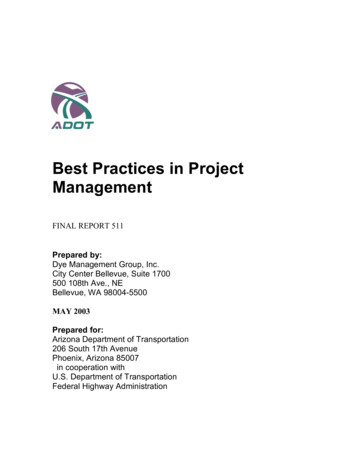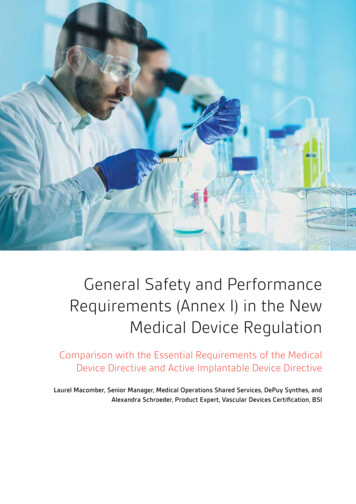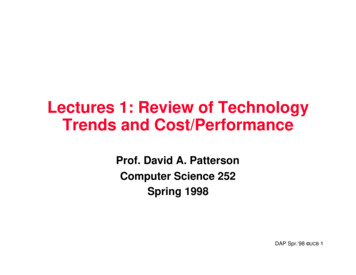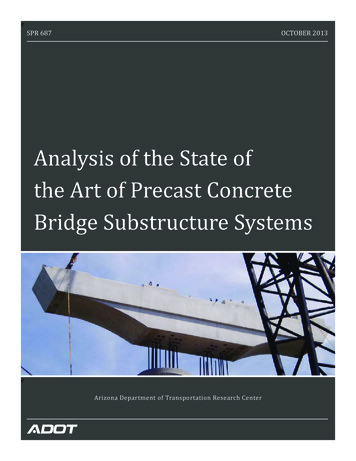
Transcription
Best Practices in ProjectManagementFINAL REPORT 511Prepared by:Dye Management Group, Inc.City Center Bellevue, Suite 1700500 108th Ave., NEBellevue, WA 98004-5500MAY 2003Prepared for:Arizona Department of Transportation206 South 17th AvenuePhoenix, Arizona 85007in cooperation withU.S. Department of TransportationFederal Highway Administration
The contents of the report reflect the views of the authors who areresponsible for the facts and the accuracy of the data presented herein.The contents do not necessarily reflect the official views or policies of theArizona Department of Transportation or the Federal HighwayAdministration. This report does not constitute a standard, specification,or regulation. Trade or manufacturers’ names which may appear herein arecited only because they are considered essential to the objectives of thereport. The U.S. Government and The State of Arizona do not endorseproducts or manufacturers.
Technical Report Documentation Page2. Government Accession No.1. Report No.FHWA-AZ-03-5114. Title and Subtitle3. Recipient's Catalog No.5. Report DateMay 2003Best Practices in Project Management6. Performing Organization Code7. AuthorsDavid Rose8. Performing Organization Report No.9. Performing Organization Name and AddressDye ManagementCity Center Bellevue, Suite 1700,500 108th Ave., NE,Bellevue, WA 98004-550010. Work Unit No.12. Sponsoring Agency Name and Address13.Type of Report & Period Covered11. Contract or Grant No.SPR-PL-1-(59) 511ARIZONA DEPARTMENT OF TRANSPORTATION206 S. 17TH AVENUEPHOENIX, ARIZONA 85007FINAL14. Sponsoring Agency CodeProject Manager: John Semmens15. Supplementary NotesPrepared in cooperation with the U.S. Department of Transportation, Federal Highway Administration16. AbstractADOT’s ability to manage a cost-effective construction program delivery and be accountable to policy-makersand customers regarding the cost and timeliness of highway projects is at risk. The following is ADOT’s currentsituation: There is little consistency in project management. ADOT is not actively managing and controlling budget and scope. The organization does not hold itself and managers accountable for scope, budget, and quality. ADOT’s process, tools, and procedures do not enable the most effective use of human and other resources. There will be continued impacts to ADOT’s organizational capacity and health. Following are the desired outcomes from improving ADOT’s project management process:ADOT will be able to manage construction program delivery against scope, schedule, budget, and qualityobjectives on a department-wide basis at the program and project levels.ADOT will hold itself accountable for delivering the program vs. scope, schedule, budget, & quality objectives.The strategic importance of project management will be emphasized by ADOT managementADOT will increase its project focus to establish a project management culture.The importance and role of project managers and the project management discipline will be elevated.A consistent process at the project level will be established. In this way, more discipline and predictability willbe brought to the process. This will strengthen ADOT’s ability to manage overall program delivery.Scopes will be set and budgets managed at the project level. The role and authority of project managers willbe strengthened to accomplish these objectives. The decision-making will be proactive, recognizing that inproject delivery scope, schedule, and budget decisions impact each other.17. Key Wordsproject management, project scheduling, projectprogramming19. Security Classification20. Security ClassificationUnclassifiedUnclassified18. Distribution StatementDocument is available to the U.S. publicthrough the National TechnicalInformation Service, Springfield,Virginia, 2216121. No. of Pages17322. Price23. Registrant's Seal
SI* (MODERN METRIC) CONVERSION FACTORSAPPROXIMATE CONVERSIONS TO SI UNITSSymbolWhen You KnowMultiply ByTo FindAPPROXIMATE CONVERSIONS FROM SI rsmmmmkmmmmmkmmillimetersmetersmeterskilometersTo ftydmi0.001610.7641.1952.470.386square inchessquare feetsquare yardsacressquare milesin2ft2yd2acmi20.0340.26435.3151.308fluid ouncesgallonscubic feetcubic yardsfl ozgalft3yd30.0352.2051.102ouncespoundsshort tons (2000lb)ozlbTAREAsquare inchessquare feetsquare yardsacressquare miles645.20.0930.8360.4052.59square millimeterssquare meterssquare metershectaressquare kilometersmm2m2m2hakm2mm2m2m2hakm2Square millimetersSquare metersSquare metershectaresSquare ic meterscubic metersmLLm3m3mLLm3m3milliliterslitersCubic metersCubic metersgkgmg(or “t”)gkgMgVOLUMEfl ozgalft3yd3Multiply ByLENGTHAREAin2ft2yd2acmi2When You KnowVOLUMEfluid ouncesgallonscubic feetcubic yardsNOTE: Volumes greater than 1000L shall be shown in m3.MASSozlbTºMASSouncespoundsshort tons (2000lb)28.350.4540.907gramskilogramsmegagrams(or “metric ton”)TEMPERATURE (exact)FFahrenheittemperature5(F-32)/9or (F-32)/1.8Celsius lsºCºgramskilogramsmegagrams(or “metric ton”)TEMPERATURE (exact)CCelsius MINATIONfcflfoot candlesfoot-Lambertspoundforcepoundforce persquare inchFahrenheittemperatureºFILLUMINATIONFORCE AND PRESSURE OR STRESSlbflbf/in21.8C lpoundforcepoundforce persquare inchlbflbf/in2FORCE AND PRESSURE OR STRESSnewtonskilopascals0.2250.145
TABLE OF CONTENTSBEST PRACTICES IN PROJECT MANAGEMENT: FINAL REPORT ANDIMPLEMENTATION PLAN EXECUTIVE SUMMARY.1BACKGROUND.1APPROACH.1PRINCIPAL FINDINGS – RISKS FROM BUSINESS AS USUAL.1PRINCIPAL FINDINGS – BENEFITS OF CHANGE .2DESIRED OUTCOME FROM AN IMPROVED PROJECTMANAGEMENT PROCESS .2RECOMMENDATIONS .3IMPLEMENTATION .5I. INTRODUCTION AND BACKGROUND .6INTRODUCTION.6BACKGROUND.6FINAL REPORT ORGANIZATION.8II. FINDINGS, RECOMMENDATIONS, AND IMPLEMENTATION .9INTRODUCTION.9BACKGROUND.9WHY ADOT SHOULD TAKE ACTION .11DESIRED OUTCOME FROM A FULLY REFORMED PROCESS .13SUCCESS FACTORS.13IMPLEMENTATION ORGANIZATION.15PHASE I – ESTABLISH IMPROVEMENT PROJECT AND PREPAREDETAILED WORK PLAN .17PHASE II – DESIGN AND IMPLEMENT IMPROVED PROCESS,TOOLS, ACCOUNTABILITY MECHANISMS, ANDORGANIZATIONAL STRUCTURE.18PROJECT MANAGEMENT TOOLS, REPORTING SYSTEMS, ANDMANAGEMENT INFORMATION.24III. CRITICAL ISSUES ANALYSIS .34INTRODUCTION.34APPROACH.34ADOT CONTEXT .35SUMMARY OF CRITICAL ISSUES IDENTIFIED THROUGHINTERVIEWS .37CRITICAL ISSUES IDENTIFIED THROUGH INTERVIEWS .43PROJECT MANAGEMENT FOR INDIVIDUAL PROJECTS.52CONCLUSIONS .63
IV. CURRENT PRACTICES .65INTRODUCTION.65PROJECT MANAGER AND PROJECT TEAM ROLES,RESPONSIBILITIES, AND AUTHORITY.70PROJECT MANAGEMENT TOOLS, INFORMATION ANDREPORTING SYSTEMS, AND TEAM BUILDING .74EXECUTIVE-LEVEL LEADERSHIP FOR PROJECT MANAGEMENT.85V. BEST PRACTICES RESEARCH .88INTRODUCTION.88APPROACH.88LITERATURE REVIEW.90BEST PRACTICES RESEARCH.105REFERENCES .115APPENDIX A: INTERVIEWEES .117APPENDIX B: SAMPLING OF PERFORMANCE MEASURES FROM THEMINNESOTA DEPARTMENT OF TRANSPORTATION, THE NEWMEXICO HIGHWAY TRANSPORTATION DEPARTMENT, AND THEWASHINGTON STATE DEPARTMENT OF TRANSPORTATION.119APPENDIX C: SURVEY QUESTIONNAIRE, SUMMARY OF RESPONSESFROM BENCHMARKING STATES, AND INNOVATIVE PRACTICESBY STATES IN IMPROVING PROJECT MANAGEMENT .123
LIST OF TABLESTable 1: Critical Issues Summary – Overall Program Delivery Management . 38Table 2: Critical Issues Summary – Project Management. 40Table 3: Example of Multiple, Overlapping Sources that are not cross-referencedthat refer to the same aspects of the Project Development Process:Project Scoping Alternatives—Scoping Letter, Project Assessment, orLocation/Design Concept Report. 69Table 4: ADOT Project Management Roles: Project Team, Technical Manager,Project Manager, and Technical Leader . 71Table 5: How Project Managers are Empowered at ADOT (Subject to TeamConcurrence). 72Table 6: The Project Manager’s Role in Scoping by Step and Activity. 78Table 7: Functional Project Management vs. Projectized Management. 93Table 8: Respective Roles of Project Manager, Functional Manager, and ProjectTeam on a Project-Oriented Entity . 95Table 9: Tools for Identifying and Correcting Schedule Problems . 102Table 10: The Weighted Elements of a Composite Design Quality Index. 131Table 11: MnDOT’s Preconstruction Performance Measures. 135Table 12: NJDOT Performance Factors and Weightings for Project ManagerAppraisal . 139Table 13: Project/Program Delivery Results Tracked by NMHTD. 143Table 14: UDOT’s PPMS Attributes List, Used to Establish Project Schedule. 151Table 15: Specification of Work Unit Roles in ODOT Plans, Specifications, andEstimates Development . 156Table 16: Overall Roles of the Project Manager and Resident Engineer at ProjectConstruction Phase: the New Jersey DOT Approach . 161Table 17: The Roles of the Project Manager and the Resident Engineer in ProjectSchedule, Cost, and Quality Control: the New Jersey DOT Approach . 162Table 18: MnDOT’s Footprint Template Approach. 164LIST OF FIGURESFigure 1: ADOT’s Project Issue Resolution Process. 73Figure 2: Opportunities to Influence Construction Cost are much Higher atScoping and Predesign than in later Project Phases. 97Figure 3: Example of Detail Required for Scope Management. 99Figure 4: ODOT’s Project Development Guidebook Succinctly Specifies EachWork Unit’s Roles by Project Phase and Major Activity . 154
GLOSSARY OF ACRONYMSAASHTOAmerican Association of State Highway Transportation OfficialsADOTArizona Department of TransportationAPSRActive Project Status ReportARTEMISAutomated Reporting, Tracking, and Evaluation ManagementInformation SystemBCDPBudgeted Cost of Deliverables ProducedBCDSBudgeted Cost of Deliverables ScheduledBVIBid Variation IndexCDSEChief Deputy State EngineerCEVPCost Estimate Validation ProcessCIPCapital Improvement ProgramCOGCouncil of GovernmentsCore TeamADOT’s Senior Management Team composed of Director,Deputy Director, and Head of each Division.CPEIConsultant Performance Evaluation IndexCPMSCapital Program Management SystemDCRDesign Concept ReportDOTDepartment of TransportationD-REWIDesign-Related Extra Work IndexEA/EISEnvironmental Assessment/Environmental Impact StatementECSEngineering Consulting SectionEISEnvironmental Impact StatementFHWAFederal Highway AdministrationFTEFull Time EquivalentFYFiscal YearGAOUnited States General Accounting OfficeHESHighway Engineering SafetyIRPIssue Resolution ProcessISOInternational Organization for StandardizationITInformation TechnologyITDIntermodal Transportation Division
ITSIntelligent Transportation SystemsL/DCRLocation/Design Concept ReviewPAProject AssessmentPCRProject Change RequestPDEProject Development EngineerPDPMProject Development Process ManualPEProfessional EngineerPEPProject Evaluation ProcessPMProject ManagerPMPProject Management PlanPPMSProgram and Project Management SystemPRBProject Review BoardPS&EPlans, Specifications and EstimatesPSQAPProject Specific Quality Assurance PlansPWPProject Work PlanPWSProject Work ScheduleQEIQuantity Estimates IndexREResident IMStatewide Long-Term Improved ManagementSPISchedule Performance IndexSPMSStatewide Project Management SectionSPRState Planning & ResearchSTDEVStandard DeviationSTIPState Transportation Improvement PlanSURFSchedule Update Request FormTACTechnical Advisory CommitteeTEA-21Transportation Equity Act for the 21st CenturyTRACSTransportation Accounting SystemTSCTransportation Service CenterWBSWork Breakdown Schedule
BEST PRACTICES IN PROJECT MANAGEMENT:FINAL REPORT AND IMPLEMENTATION PLANEXECUTIVE SUMMARYBACKGROUNDThis executive summary presents an overview of the research, analysis, findings, andrecommendations from a major study of Arizona Department of Transportation (ADOT)project management practices and processes that was conducted by Dye Management Group,Inc.APPROACHThe researchers evaluated ADOT’s project management process against industrybest practices. Dye Management Group, Inc.’s methodology: Involved ADOT employees, business partners, and customers in identifying thecritical issues confronting ADOT. Analyzed ADOT’s documented policies and procedures. Analyzed actual ADOT practices. Evaluated issues, policies and procedures, and actual practices againstindustry best practice.PRINCIPAL FINDINGS – RISKS FROM BUSINESS AS USUALADOT’s ability to manage a cost-effective construction program delivery and beaccountable to policy-makers and customers regarding the cost and timeliness of highwayprojects is at risk. The following is ADOT’s current situation: There is little consistency in project management. ADOT is not actively managing and controlling budget and scope. The organization does not hold itself and managers accountable for scope,budget, and quality. ADOT’s process, tools, and procedures do not enable the most effective use ofhuman and other resources. There will be continued impacts to ADOT’s organizational capacity and health.1
PRINCIPAL FINDINGS – BENEFITS OF CHANGEThe benefits of an improved project management process include: Ability to establish, manage, and actively control project costs to ensure costeffective delivery of the construction program. Capacity to realize delivery efficiencies. Ability to address quality control and associated cost issues. Increased transparency and accountability for ADOT. Better human resource management and increased staff productivity. Increased precision in managing program delivery and performing cashmanagement across multiple years.DESIRED OUTCOME FROM AN IMPROVED PROJECT MANAGEMENTPROCESSFollowing are the desired outcomes from improving ADOT’s project managementprocess: ADOT will be able to manage construction program delivery against scope,schedule, budget, and quality objectives on a department-wide basis at theprogram and project levels. ADOT will hold itself accountable for delivering the program against scope,schedule, budget, and quality objectives. The strategic importance of project management will be emphasized by ADOTmanagement ADOT will increase its project focus to establish a project management culture. The importance and role of project managers and the project managementdiscipline will be elevated at ADOT. A consistent process at the project level will be established. In this way, morediscipline and predictability will be brought to the process. This will strengthenADOT’s ability to manage overall program delivery. Scopes will be set and budgets managed at the project level. The role andauthority of project managers will be strengthened to accomplish theseobjectives. The decision-making will be proactive, recognizing that in projectdelivery scope, schedule, and budget decisions impact each other.2
RECOMMENDATIONSThe study findings provide the following recommendations for the new processand strongly support the idea that they should be implemented as a package. Togetherthey provide the elements of a reformed project management process.Recommendations for Strategic Direction for Project ManagementThe recommendations are intended to ensure that there is department-wideaccountability for and ownership of accomplishing project management objectives. Therecommendations provide the department-wide leadership with direction to strengthenADOT’s project management culture.Recommendation 1. Develop ADOT’s project management culture by providingclear, consistent, executive communication and leadership regarding the department-wideimportance of project management objectives and their accomplishment.Recommendation 2. Establish department-wide ownership and accountability bysenior management for strategic objective accomplishment in scope, budget, schedule,and quality.Recommendation 3. Establish measurable ADOT strategic objectives for scope,budget, schedule, and quality and measure their accomplishment.Recommendations for Roles and Responsibilities of the Project ManagerThese recommendations address the concerns that project management at ADOTis inconsistent. There is no widely shared understanding of the role of the projectmanager or the project team; project management practices vary widely and the extent towhich projects are actively managed at all is variable. The intent of the recommendationsdetailed below is to increase the consistency and discipline with which best projectmanagement practices are applied at ADOT.Recommendation 4. Establish department-wide the roles, responsibilities, andauthority of project managers, project teams, technical managers, technical leaders, andteam members. Strengthen the project manager’s level of authority.Recommendation 5. Strengthen the consistency of project management acrossADOT by establishing consistent project management procedures.Recommendation 6. Revise project management policies, guidelines, andmanuals to reflect these consistent project management requirements.Recommendation 7. Establish measurable performance objectives for projectmanagers that are aligned with ADOT strategic objectives and project managers’ roles,responsibilities, and authority.3
Recommendations for Project Management Tools, Reporting Systems, andManagement InformationThese recommendations address the imperative for consistent department-levelinformation on project delivery status and for bridging the significant gaps in projectlevel information that form barriers to improved project management. Moreover, manyADOT project managers and other process participants state that they derive limitedvalue from their current data reporting activities. The intent of the recommendations is tomove toward a situation in which the highest performing managers are those who use thetools because they are helping them plan, execute, monitor, and control their work.Recommendation 8. Develop and maintain department-wide project statusinformation regarding project scope, schedule, and budget.Recommendation 9. Strengthen scope management by revising policies andprocedures to establish greater accountability and reporting mechanisms.Recommendation 10. Establish a standardized process for project scheduleplanning and management.Recommendation 11. Establish and manage project budgets.Recommendation 12. Use quantitative information to evaluate ADOT laborrequirements and establish work standards by activity to support project scheduling andbudgeting.Recommendation 13. Perform multi-project resource loading to evaluate the“deliverability of the program” and support overall program management.Recommendations for Organizational Development to Strengthen ADOT’s ProjectManagement FunctionThe recommendations address the study findings that strengthened projectmanagement requires elevating and supporting the development of project managementas a discipline within ADOT.Recommendation 14. Create a department-wide organizational focal point for allproject management at ADOT.Recommendation 15. Establish project management as a visible and attractiveADOT career path.Recommendation 16. Continue to emphasize and amplify training andprofessional development for project managers. This recommendation builds on theexisting level of commitment to training for project managers and team members.4
IMPLEMENTATIONADOT needs to implement the package of recommendations in their entirety. It isrecognized that there are a number of improvements underway to address quality,improve management reporting systems, and enhance partnering and other aspects thatimpact project management; however, the Tactical Advisory Committee (TAC) at theirmeeting on February 28, 2003 endorsed these recommendations and initiated theirrequest that ADOT management pursue their timely implementation. The TAC expressedagreement that partial change exacerbates the problems by not really getting to the rootcause of the problems. For successful implementation, ADOT must implement therecommendations as a package, provide executive commitment, and allocate thenecessary resources.Initial Steps and OrganizationThe study recommends the following implementation steps:1. Secure Executive Sponsorship for Implementation.2. Appoint an Implementation Manager and Team.3. Have the Team Develop and Implement the Reformed Process.Resource RequirementsSuccessful implementation requires the dedication of resources to manageimplementation and resources to address individual recommendation areas. Initialimplementation steps will determine resource requirements. Although ADOT’s budget ishighly constrained at present, successful implementation will yield a high return on investmentand quickly pay for itself. The allocation of resources will determine how quickly therecommendations can be implemented.5
I.INTRODUCTION AND BACKGROUNDINTRODUCTIONThis document is the final report for the Arizona Department of Transportation’s(ADOT) Best Practices in Project Management Study. This study was performed by DyeManagement Group, Inc. under the direction of a Technical Advisory Committee (TAC).The recommendations developed through this study involved many ADOT employeesand drew upon Dye Management Group, Inc.’s research findings and first handexperience assisting other states to improve project management.BACKGROUNDThis final report combines the individual interim reports prepared during thecourse of the study. These interim reports were planned and sequenced to: Ensure that the consultant team focused on the issues of greatest concern toADOT. Provide grounding in the theory, tools, and techniques of project managementthrough a survey of best practices among other state departments oftransportation. Identify best practices in project management. Establish a baseline description of ADOT’s current project managementapproaches, documentation, systems, and business practices. Develop an integrated set of recommendations endorsed by the TechnicalAdvisory Committee. Provide guidance on the how ADOT can implement the studyrecommendations.Study Interim ReportsPrior study interim reports that this research report is based on are listed below:Interim Report 1: Best Project Management Practices: Critical Issues. Toprepare this interim report the consultant team interviewed ADOT executives, managers, andstaff in order to elicit their views as to the most pressing issues in project and program deliveryat ADOT. This interim report provided extensive base line documentation regarding theperception and reality of project management at ADOT.6
Interim Report 2: Best Project Management Practices Literature Review. In aneffort to identify industry best practices in project and program delivery, the consultant teamconducted a literature review which referenced journal articles, books, and Websites. A keyfinding was that public sector infrastructure providers are turning to project management—notonly as a tool for discrete pieces of work—but also as an overarching, department-widestrategy more aptly described as “management by project.” This literature review focused onthe characteristics of “project-oriented” organizations, which include structures ofaccountability at levels throughout the department, a well defined approach to projectmanagement structure, generally some variation of “matrix management” and projectmanagement information technology that allows for effective project and program-levelplanning and control.Interim Report 3: Best Project Management Practices: Best Practices Survey.The purpose of this survey was to identify “best practices in project management” as developedby other state departments of transportation (DOTs). Based on input from the ADOT TechnicalAdvisory Committee as well as consultant team experience, seven DOTs were selected forreview: Massachusetts, Minnesota, Michigan, New Jersey, New Mexico, Utah, andWashington. In addition, project management training materials, computer documentation,manuals, reports, bidding documents, and capital improvement programs from 22 other stateswere analyzed. Among the findings of this survey were that program managers rely on projectmanagement as a means of planning, monitoring, and controlling the allocation of resources atthe department level. Another finding was that most states are in the process of movingtoward stronger matrices and no state was found to be moving toward a weak matrix,which ADOT has adopted.Interim Report 4: Best Project Management Practices: Assessment of ADOTPractices. This interim report examined ADOT’s current project and program managementapproaches, documentation, and systems. The consultant team’s research methodologyincluded a review of ADOT specifications, progress and financial reports, audits, trainingmaterials, and other written documentation as well as multiple rounds of interviews withADOT executives, managers, staff, and partners.Interim Report 5: Best Practices in Project Management: Findings andRecommendations. This interim report provided an integrated set of recommendations thataddressed the change to business process, project manager roles and responsibilities,department-wide management, human resource management, reporting systems andprocedures necessary to strengthen project management.Interim Report 6: Implementation Plan. This interim report identified theimplementation steps required for ADOT to implement the recommendations identified in priorstudy interim reports.7
FINAL REPORT ORGANIZATIONThe final report is organized into the following chapters. To emphasize theimportance of the findings, recommendations, and implementation plan, they arepresented prior to the research, results,
Best Practices in Project Management FINAL REPORT 511 Prepared by: Dye Management Group, Inc. City Center Bellevue, Suite 1700 500 108th Ave., NE Bellevue, WA 98004-5500 MAY 2003 Prepared for: Arizona Department of Transportation 206 South 17th Avenue Phoenix, Arizona 85007 in cooperation with U.S. Department of Transportation










